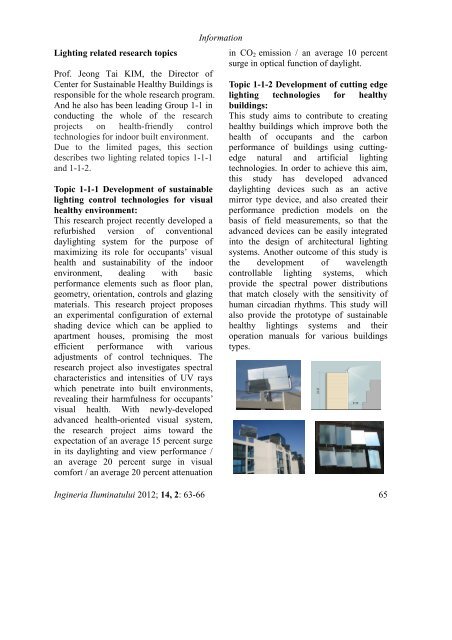Untitled - Journal of Lighting Engineering
Untitled - Journal of Lighting Engineering
Untitled - Journal of Lighting Engineering
Create successful ePaper yourself
Turn your PDF publications into a flip-book with our unique Google optimized e-Paper software.
<strong>Lighting</strong> related research topics<br />
Pr<strong>of</strong>. Jeong Tai KIM, the Director <strong>of</strong><br />
Center for Sustainable Healthy Buildings is<br />
responsible for the whole research program.<br />
And he also has been leading Group 1-1 in<br />
conducting the whole <strong>of</strong> the research<br />
projects on health-friendly control<br />
technologies for indoor built environment.<br />
Due to the limited pages, this section<br />
describes two lighting related topics 1-1-1<br />
and 1-1-2.<br />
Topic 1-1-1 Development <strong>of</strong> sustainable<br />
lighting control technologies for visual<br />
healthy environment:<br />
This research project recently developed a<br />
refurbished version <strong>of</strong> conventional<br />
daylighting system for the purpose <strong>of</strong><br />
maximizing its role for occupants’ visual<br />
health and sustainability <strong>of</strong> the indoor<br />
environment, dealing with basic<br />
performance elements such as floor plan,<br />
geometry, orientation, controls and glazing<br />
materials. This research project proposes<br />
an experimental configuration <strong>of</strong> external<br />
shading device which can be applied to<br />
apartment houses, promising the most<br />
efficient performance with various<br />
adjustments <strong>of</strong> control techniques. The<br />
research project also investigates spectral<br />
characteristics and intensities <strong>of</strong> UV rays<br />
which penetrate into built environments,<br />
revealing their harmfulness for occupants’<br />
visual health. With newly-developed<br />
advanced health-oriented visual system,<br />
the research project aims toward the<br />
expectation <strong>of</strong> an average 15 percent surge<br />
in its daylighting and view performance /<br />
an average 20 percent surge in visual<br />
comfort / an average 20 percent attenuation<br />
Information<br />
in CO2 emission / an average 10 percent<br />
surge in optical function <strong>of</strong> daylight.<br />
Topic 1-1-2 Development <strong>of</strong> cutting edge<br />
lighting technologies for healthy<br />
buildings:<br />
This study aims to contribute to creating<br />
healthy buildings which improve both the<br />
health <strong>of</strong> occupants and the carbon<br />
performance <strong>of</strong> buildings using cuttingedge<br />
natural and artificial lighting<br />
technologies. In order to achieve this aim,<br />
this study has developed advanced<br />
daylighting devices such as an active<br />
mirror type device, and also created their<br />
performance prediction models on the<br />
basis <strong>of</strong> field measurements, so that the<br />
advanced devices can be easily integrated<br />
into the design <strong>of</strong> architectural lighting<br />
systems. Another outcome <strong>of</strong> this study is<br />
the development <strong>of</strong> wavelength<br />
controllable lighting systems, which<br />
provide the spectral power distributions<br />
that match closely with the sensitivity <strong>of</strong><br />
human circadian rhythms. This study will<br />
also provide the prototype <strong>of</strong> sustainable<br />
healthy lightings systems and their<br />
operation manuals for various buildings<br />
types.<br />
Ingineria Iluminatului 2012; 14, 2: 63-66 65
















